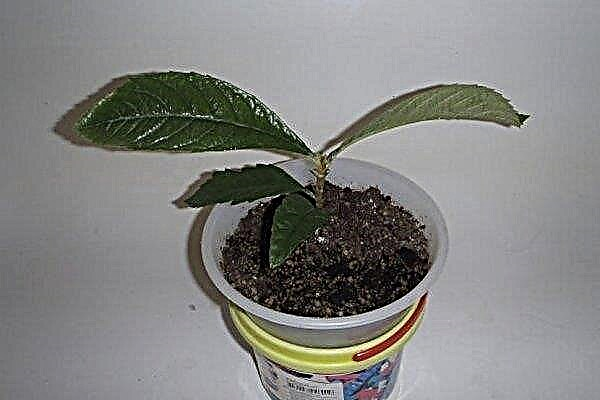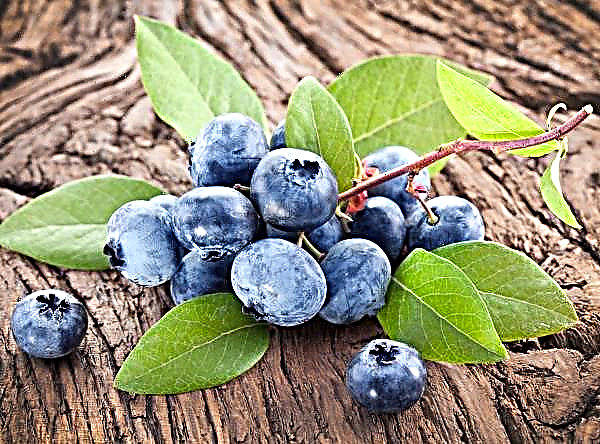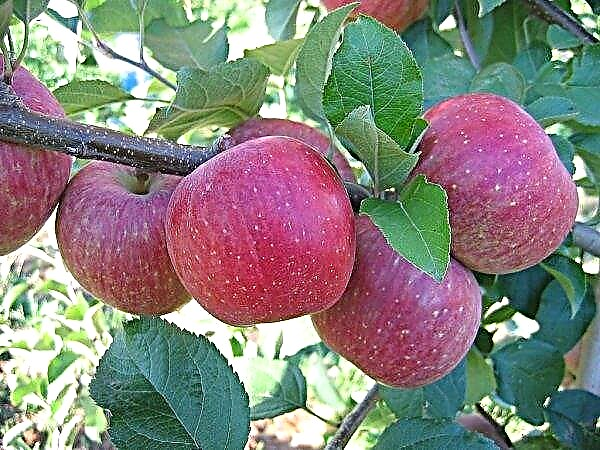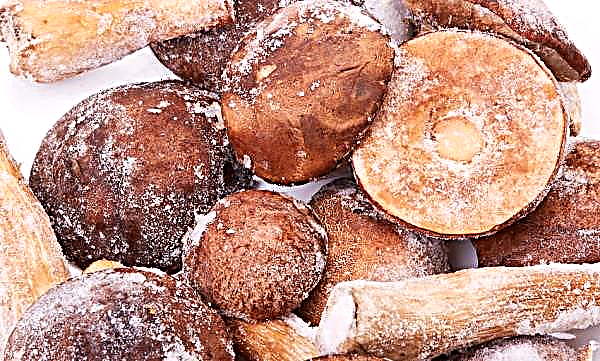Juniper is a perennial coniferous culture that is characterized by high medicinal properties and is widely used as an ornamental plant in the field of landscape design, decoration of personal plots, parks or gardens. Perennial is characterized by a slow growth rate, but in order to give it an aesthetically attractive appearance, it needs regular pruning. Learn how and when to trim the juniper shoots, and what are the features of cutting different varieties of culture - learn from the article.
What tools do you need to cut
Immediately before you begin the process of cutting the juniper, you must first prepare a number of tools and materials:
- garden special scissors that are equipped with a long lightweight handle;
- sharpened secateurs. To remove the shoots, experts advise using a tool with an elongated blade, which allows you to cut branches less than 2 cm. To cut thick, large shoots, it is advisable to choose a secateurs with a ratchet mechanism;
- preparations for processing slices. As such, it is recommended to use crushed coal or garden var.

The predominant part of junipers is poisonous, therefore, when carrying out work, it is always necessary to use personal protective equipment: gloves, a special suit. When plant juice gets on the skin, it can cause various allergic reactions: itching, redness, rash, irritation, severe pain. If this happens, immediately rinse the juice with a solution of laundry soap.
Ways and types of pruning in summer, autumn and spring
There are several types of pruning of juniper, each of which is performed according to a clear algorithm, at a specific time of the year and has a specific purpose. As a rule, crop mowing events are carried out in the springtime, from mid-April to late May, or in the fall, in September – October. Regardless of the season, the procedure is carried out on a cloudy, non-hot day, previously a day, moistening the crown of the bush with moisture by sprinkling.
Important! It is very important to cut branches with sharpened and sanitized tools. An even and accurate cut “heals” faster, is less susceptible to various infections and bacteria.
Circumcision of the described perennial is carried out by two methods:
- Point. This method allows you to save the natural form of the bush. It makes the crown thick and dense, suitable for young specimens. During the procedure, each twig is cut at an angle of 45 degrees by one fully formed kidney, 2 cm higher from it.
- Blindly. Such a haircut makes it possible to give the culture any desired shape. In this case, the young shoots are completely removed, and all the rest are cut off around the perimeter, regardless of the location of the kidneys.

Juniper pinching
When forming the desired type of perennial, gardeners practice pinching growing shoots. Until the young branch is lignified, and the needles continue to grow, the axillary buds do not lose the ability to form perfectly for the formation of an escape in the second year. Thus, there is a chance to get branches of the desired size, to stimulate or, conversely, to slow down the growth of shoots in the desired direction.
Did you know? The oldest juniper grows today on the territory of the Crimean peninsula. According to some reports, his age is 400 years, but many scientists claim that he reaches 2000 years. Accurately determining the age of a living plant is extremely difficult.
It is especially successful to apply the nipping of shoots in case it is necessary to change the shape of a young shrub. By removing or making smaller the most powerful and strong branches, you can get a stronger plant than it would have grown without outside interference. The simplest pinching method is to pinch the ends of the growing branches or to cut the awakening central buds.
 But it should be noted that the pinching procedure is quite time-consuming and ineffective if the number of shoots on the juniper is too large. That is why the classical forming haircut is more suitable for the described species of plants.
But it should be noted that the pinching procedure is quite time-consuming and ineffective if the number of shoots on the juniper is too large. That is why the classical forming haircut is more suitable for the described species of plants.
It is advisable to carry out events in the early spring before the beginning of budding. In this case, all the shoots are pinched, which makes it possible to further intensify the development of not one large shoot, but numerous short branches. Such manipulations allow the formation of dense, dense and compact shrubs with an even and regular crown shape.
Thinning pruning
Thinning shrub cutting is necessary in order to make the crown less dense and dense. High thickening is fraught with the development of various pathogenic microorganisms and harmful microflora. Thinning pruning is influenced by highly growing juniper varieties. During the procedure, shoots growing deep into the bush, as well as “forks”, which can lead to breaking of the plant, are removed.
Such pruning has a number of positive qualities:
- improves air exchange inside the crown;
- removes excess moisture;
- prevents the formation of fungal infections and the appearance of pests.
 The best time for cutting a perennial is early spring or the last decade of August.
The best time for cutting a perennial is early spring or the last decade of August.
Sanitary pruning
Sanitary pruning is done to restore, improve the plant, as well as to prevent a variety of ailments and parasites. As a rule, it is carried out in early spring until the moment when the phase of sap flow begins. During this period, broken, too weak, damaged, diseased shoots are removed. Branches that have received burns from direct sunlight, it is recommended to leave, systematically throughout the growing season, checking their condition. If the shoots do not recover, then in the fall they should also be removed.
During the summer period, sanitary pruning will be required for the plant if it is infected with fungal diseases. Sick shoots are completely cut off to prevent the spread of the disease in healthy tissues. In the fall, if there are broken, dried or obsolete branches on the shrub, they are also pruned.

Particular attention should be paid to the types of junipers that spread along the surface of the soil and have a dense, dense crown. Quite often, thickened plantings become an excellent source of fungal development. If dried or weak shoots are left on the shrub, an infectious focus may arise, which, spreading, can destroy the whole culture.
Formative
Most juniper varieties belong to the category of rapidly growing plants, therefore, cutting activities are aimed more at inhibiting the active growth of shoots and creating an attractive, neat form of the bush. There are varieties of culture that grow slowly, so in this case, the forming pruning allows gardeners to get a decorative curly shrub that does not require regular shape adjustments. There are several main types of shaping haircuts, the features of each of them - find out further.
Important! Regardless of the type of pruning, it is impossible to remove more than 1/3 of the aerial parts of the plant in one procedure.
Topiary
Topiary cutting is done by gardeners at their discretion in the event that the natural shape of the bush has lost geometricity, regularity or symmetry, or if you want to give the plant an original unusual shape. However, speaking of giving the tree “any” shape, it should be clarified that it must be as natural as possible, otherwise the perennial can get stress, and as a result, undergo various ailments. For example, do not try to make the spiral shape of the crown from a squat, creeping on the soil of the bush.

Juniper should be selected according to several important aspects:
- Grade. Such varieties as Kuriwao Gold, Blue Point are suitable for forming a ball or other similar forms. A cube and arbitrary shapes can be created from the varieties of the perennial as the ball, as well as from the rocky shrub Wichita Blue. From junipers Skyrocket, Wichita Blue, as well as ordinary Compressa, amazing pyramidal, spiral, conical and chess pieces are obtained. The cylinder shape can be obtained from the varieties Meyer, Hibernica and Chinese Spartan.
- Skeletal structure of the bush. From the entire mass of shoots, it is necessary to choose those that are located correctly, in accordance with the desired shape. The rest should be shortened or completely trimmed, while leaving those branches that grow up. In subsequent years, only young shoots need to be shortened, with no more than 25% of the total growth. Thus, the horizontal, Cossack and rock varieties of juniper are sheared. The ordinary does not need annual formation. To increase the density of its crown, it is enough to carry out surface cutting of young shoots.
- The gardener's experience. Another factor that matters when performing circumcision is the experience of the gardener. If the haircut is carried out for the first time, then you must first form as close as possible to the natural form of the bush, for example, a cube or ball. If the desired figure has edges, then experts recommend using special patterns. After the simple forms will be fully mastered by the gardener, you can proceed to the creation of more complex, voluminous figures.
Video: juniper topiary
Specialists advise carrying out measures for the formation of shrubs in the spring, from April to May, or in the fall, until the end of October. It is not recommended to prune the shoots from June to July, when the plant is at the peak of sap flow.
Important! The shrub normally tolerates a haircut, however, so that it can restore power faster, it is recommended to spray the crown with any growth stimulator, for example, Epin or Emistim.
Spiral
A spiral haircut is more complex than a simple topiary. First of all, it begins with the formation of a cone or column, which subsequently needs to be turned into spiral coils. To make it easier to create spiral-shaped turns, their lines are marked on the shrub with a wide floral tape or acrylic-based paint. The number of turns can be different, however, as practice shows, three- or five-turn figures most effectively look. After the marking is set, you can create a spiral: first, a rough haircut of the contour along the tape with a secateurs is carried out, and then with the help of scissors form the final desired appearance.
Depending on the width of the contour, which determines the interval between the turns, the spiral is divided into two types:
- spindle - with a large amount of contour;
- corkscrew - with the same width of the turns.
 Trimming juniper is allowed in spring or autumn. But you should pay attention to the fact that the first cutting should be done no earlier than two years after planting a seedling in a permanent place.
Trimming juniper is allowed in spring or autumn. But you should pay attention to the fact that the first cutting should be done no earlier than two years after planting a seedling in a permanent place.
Curly haircut
Curly hair is the most complex and time-consuming of all, since it requires certain skills and experience from the gardener. First, experts recommend practicing creating simple geometric shapes: a cube, a ball, a cone. Further, with a “full hand” one can proceed to the formation of more complex figures in the form of animals, people, and decor items.
Did you know? Juniper wood is considered one of the best materials for joiners and carvers. Dried raw materials never crack, has extremely high strength and allows you to make very thin threads.
To facilitate the task, it is recommended to use special patterns during curly haircuts. If the shrub that is planned to be pruned is not young, then immediately before the procedure it is necessary to conduct a rejuvenating pruning.

Recommendations for pruning different types and varieties
As noted above, the method of cutting juniper will largely depend on the variety of culture. The fact is that many of the varieties have a genetic predisposition to the formation of a crown of one form or another. There are junipers with a horizontal, ordinary or rocky crown, the trimming of which has some features.
Ordinary
Juniper in form can be tree-like, up to 15 m high, shrubby and undersized (dwarf). Depending on the type, the trimming method is also chosen. When growing a beautiful large tree, it is enough in early spring to cut off damaged, dry, broken shoots. Low-growing species should be thinned out, to prevent thickening. It is advisable to form shrub plants using the topiary method, creating beautiful, regular geometric shapes from them.

Horizontal
Horizontal juniper belongs to the category of creeping undersized crops, has a flat crown and reaches a height of not more than 50 cm. Perennial grows rather slowly, its annual growth rarely exceeds 5-10 cm, which is why it does not need frequent pruning of shoots.
The cutting procedure is reduced to removing old, dry, diseased shoots, shortening branches that stand out from the general form, as well as those that thicken the bush or fall to the ground under the weight of their weight.

Creeping
Creeping juniper, it is horizontal or dwarf, rarely grows above 50 cm. Has a spreading flat crown and long shoots. To preserve the decorativeness of the crop, it is necessary to trim the shoots that extend beyond the crown or thicken it too much. A topiary haircut allows the plant to form the desired shape. In addition, to remove infected, broken or dried branches in the early spring or autumn.
Rocky
Rock juniper is presented in the form of a spectacular shrub or tree, the height of which can reach up to 18 m in natural conditions. The culture is characterized by the presence of an irregular conical crown, which is rounded during the growth of the plant. In this case, the crown in rock varieties begins to grow almost from the base.
The juniper of the described variety does not need a forming haircut, since its crown naturally has a luxurious, decorative appearance. However, sanitary pruning is necessary for the shrub. It is carried out by the traditional method, in the early spring before the start of sap flow, removing dried, injured, infected with the disease or pests, branches.
 If you need to align the contours of the crown, then experts advise to shorten all the branches sticking out and falling out of the general shape, but not more than by 20 mm, since over the year the growth of the described culture is about 10 cm.
If you need to align the contours of the crown, then experts advise to shorten all the branches sticking out and falling out of the general shape, but not more than by 20 mm, since over the year the growth of the described culture is about 10 cm.
Old juniper
Adult plants need shaping and sanitary pruning. As a rule, they do not require a rejuvenating haircut, since without it they are able to grow perfectly for several tens, or even hundreds of years.
It is advisable to form adult plants in early spring, before the start of the active phase of vegetation.But sanitary circumcision is allowed to be carried out at any right time, since the presence of damaged shoots on the bush brings much more serious harm than their untimely pruning.
 To make the crown denser and denser, 1/3 of all branches can be cut.
To make the crown denser and denser, 1/3 of all branches can be cut.
Cossack
The most common and most popular type of juniper is Cossack, presented in the form of a ligneous creeping bush, about 1.5 m high, which is characterized by the ability to rapidly grow and form thickets. For this reason, the plant needs regular pruning, which is carried out by the topiary method. This method of cutting allows you to slow down the growth of young shoots and improve the decorative appearance of the bush.
Did you know? In ancient times, juniper was endowed with magical powers. So, the clergy hid the consecrated branches of the plant behind the icons, believing that such a measure would protect the temple from evil spirits and evil spirits.
The cutting pattern consists of the following stages:
- from all shoots, those that have the correct, desired shape, location are selected;
- the remaining coniferous mass is cut out, leaving only those branches that grow upward.
In the following seasons, when forming the Cossack perennial, about 25% of the growth of young shoots should be cut. The best time for events is considered to be from April to May and from September to October.
Video: Cossack juniper haircut
Juniper is an evergreen perennial that needs regular shearing and sanitary pruning to maintain high decorativeness. The culture responds well to such events, however, do not subject it to severe stress, removing a large number of branches at a time. Properly performed pruning will allow you to get a beautiful, aesthetically attractive bush of the desired original shape.












